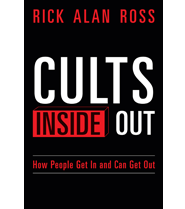Guarding Against Cultish Tendencies
Published By admin
In 2021, CBS News published “The Most Terrifying Cults in History,” which highlighted some tragic outcomes of the most prominent cults of our lifetime. The history of these groups and their charismatic leaders is disturbing. But, it’s paramount to recognize that, for the most part, our impressions of cults are primarily based on the most extreme cases—Keith Raniere, Ron Lafferty, Jim Jones, Charles Manson, Aum Shinrikyo, David Koresh, and others like them. But cults and their adherents are far more complex and their motivations more understandable than the extreme cases would suggest.
At risk of over-generalizing human behavior, psychology provides insights into the human tendencies that lead most groups to have built in cult-like characteristics (more on what constitutes a cult below).
First, people crave belonging, which psychologists point out is fundamental to human existence. But the downside of pursuing belonging is that the most straightforward, well-trodden route is conformity. People groups, whether political, social, religious, or cultural, encourage and reward conformity while discouraging, even punishing individuality and autonomy.
This may explain why most people avoid sticking out and being different—it is exceedingly stressful, difficult, and in extreme cases, potentially life-threatening. Why risk losing acceptance, inclusion, and identity? Add to the belonging conundrum humanity’s historically toxic relationship with power and tendency toward self interest, and you have fertile grounds for a cult to sprout.
The kinds of toxic, power-seeking, often charismatic individuals who become cult leaders frequently mistrust others. They seldom allow subordinates to make independent choices or hold different ideas, seeing individuality as threatening. Such figures tend to pursue environments that guarantee them control, predictability, security, and preserve their self-autonomy. At the same time, they control others’ behaviors by diminishing or eliminating their right to self-determination.
It follows that the more power-seeking individuals there are in a given group, the more ideological splits the group undergoes as these individuals conflict over whose ideas will predominate. Whenever human beings with their foibles organize into groups, cultic tendencies inevitably emerge. The only question is to what extent.
Psychologist Steve Eichel, a cult expert and president of the International Cultic Studies Association estimates that there are as many as 10,000 cults in the United States with many more scattered across the globe. This stark reality increases the likelihood of encountering a cultic group in your vicinity (or even being a member of one). Some groups may seem innocuous; many operate in the shadows, preferring to remain unnoticed.
As noted, most people’s understanding of cult groups derives from extreme cases. Most people would not associate their yoga group, spin class, or religious gathering with a cult, though the reality is that a cult can be any system or group of people who practice excessive devotion to a figure, object, idea, or belief system.
The question to ask is, “In which areas is my group displaying excessive devotion?” A fair follow-up question might be how to determine what constitutes “excessive.” I tend to fall back on the words of Jesus to help draw the line. Jesus taught his followers to “love our neighbors as ourselves” (Mark 12:31). So devotion to any given thing is excessive when valued above fellow human beings.
In her 2013 book, Leaving Church: A Memoir of Faith, Barbara Brown Taylor eloquently captured cultish religious excesses when she wrote, “As a general rule, I would say human beings never behave more badly toward one another than when they believe they are protecting God.” I take that to mean that if a given tenet of my group’s faith causes me to behave rudely—to be a jerk—then I know I’m in cult-like territory and ought to tread carefully.
The standard definition of a cult needs expanding beyond extreme examples. Defining cults narrowly, based on their most extreme manifestations prevents self-awareness and discernment of the seemingly harmless groups people routinely join and the cultish behaviors they exhibit. We have to be more discerning. It’s crucial to critically evaluate our affiliations and behaviors for signs of cultic influence. So what are some tell-tell signs of cultish behavior? What are the red flags?
Here are a few non-exhaustive key identification markers.
You are most likely participating, involved, or observing a cult if the group:
- Promotes and values an unquestioning commitment to its leader (alive or dead) regarding the leader(s) as infallible and their teachings, ideology, and practices as the universal truth or law.
- Discourages or punishes members who question or express doubts, dissent, or disbelief of the group’s ideological essence.
- Displays tight control of its members by dictating, with great detail, how they are to think, live and conduct themselves, e.g., who to marry, when to marry, what to wear, where to live, whether to have children or not, how to discipline children, gender roles, who to socialize with, etc.
- Promotes a “Us versus Them” worldview narrative in which they are always the “good guys.”
- Discourages any accountability that might threaten the group’s existence.
- A value system that always promotes bringing in new members while moralizing financial commitments to the group. Not bringing in new members or faithfully contributing financially to the group risks jeopardizing one’s status.
- Promotes the idea that there is no other way of being outside of their system. Leaving the group is often associated with choosing death over life.
- Uses guilt, fear, and shame as weapons for deterrence, control, and punishment.
- Engages in the dehumanization of people who do not hold the same convictions as them
- Celebrates and prioritizes its traditions and ideas above the humanity of its adherents.
Navigating this minefield certainly requires discernment since not all the above markers need be present for a group to qualify as a cult.
Content retrieved from: https://spectrummagazine.org/views/guarding-against-cultish-tendencies/.






